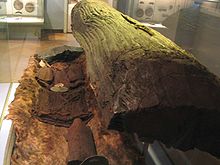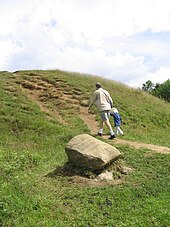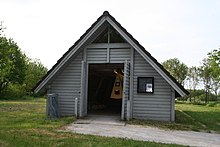Girls from Egtved
The Egtved girl (also Egtved girl ; Danish Egtvedpigen ) was a young woman who lived near Egtved , Jutland in Denmark around 1400 BC during the older Nordic Bronze Age . Was buried.
Discovery
The girl from Egtved was found on February 24, 1921 by the farmer Peder Platz when he was trying to clear the remains of a small hill. He discovered the big tree coffin made of oak in the middle of the grave mound . His called neighbor P. S. Pedersen suspected that it could be a valuable find, and together the two wrote a letter to the National Museum in Copenhagen on the same day:
- “Since I came across a hollowed-out tree trunk while leveling an old hill on my property today, I suspect that it is an old burial and that this could be of interest to the museum. That's why I stopped work. "
The letter met with great interest from the director of the National Museum, Sophus Müller . He offered to cover and guard the tree coffin for a fee until an excavation team could be on site in March. Thomas Thomsen was appointed head of this team, who meticulously documented the excavation on March 5th and 6th. Numerous photos were taken on site to record the individual steps of the excavation for posterity. On March 7, the tree coffin was sent to the National Museum, where it arrived two days later and was thoroughly examined.
The dead

In the restoration workshop of the Copenhagen National Museum, the oak coffin was examined by the conservators Gustav AT Rosenberg (1872-1940) and Julius Raklev (1878-1960). The 200 to 218 centimeter long tree coffin was hollowed out inside over a length of 180 centimeters. The felling date could be dendrochronologically dated to the year 1370 BC; it can be assumed that the girl was buried shortly afterwards.
Due to the special preservation conditions in burial mounds, large parts of the organic material in the grave have been preserved. For example, plant remains ( yarrow ) were found that show that the burial took place in summer. The dead woman was wrapped in a well-preserved cow hide . Beneath it came a large blanket woven from sheep's wool, which had been folded several times over the dead body and covered it completely.
Parts of the dead were also preserved: in addition to the young woman's soft tissues and teeth, this also includes her hair. These were cut short on the head and sides and half-length in the neck.
The girl was about 1.60 meters tall and - according to the latest dental examinations - about 16 to 18 years old.
dress
The dead woman was clothed and placed in the tree coffin with jewelry. She wore a short blouse with half-length sleeves, as is also available from the Danish Bronze Age burials of Borum Eshøj and Skrydstrup . This was woven in one piece and closed in the back with a T-shaped seam.
She wore a cord skirt around her hips , that is, a wrap skirt made of twisted woolen cords that sat on her hips and reached down to her knees. All clothing was woven from natural-colored sheep's wool. At the waist a bronze belt disc was fastened by means of a long woven belt with a decorative tassel at the end. In addition to a bronze earring, she wore two different bronze bracelets and a leg comb on her belt.
This clothing and jewelry is typical of upscale graves from the older Bronze Age in South Jutland. Even the string skirt has some parallels, none of which are as well preserved as in Egtved.
Additions
At the foot of the coffin was a large birch bark can, in which the remains of a drink could be found during the examination in the National Museum in Copenhagen . It was a sweetened with honey beer from wheat grains, Gagel and lingonberries or cranberries ; Pollen from no less than 55 different plants could be detected.
Next to the head of the dead person was another birch bark box, this contained the burned bones of a five to six year old child, possibly a close relative, possibly a human sacrifice .
Historical classification
Together with the elaborate burial mound, which was once more than 20 meters in diameter, the additions suggest that the girl from Egtved had a special social position. Bronze Age images of young women in mustaches suggest that they could also have had a function in the cultic area.
In any case, it is one of the best preserved and documented burials of the Bronze Age in Europe. This is also thanks to the finders, who sensed the importance of the find and immediately informed experts.
Origin of the girl
As the Danish National Museum announced on May 21, 2015, strontium isotope analyzes refute the assumption that the girl came from Jutland. Analyzes of the hair, teeth and fingernails combined with the strontium isotope signatures of her clothing showed that she was not born in Egtved or Denmark, but rather point to an origin in the Black Forest or its surroundings. Karin Margarita Frei from the National Museum in Copenhagen was able to determine through an analysis of the strontium isotope signatures of the hair that the young woman could only have come to Scandinavia very shortly before her death. Since the strontium isotope signature can no longer be detected in human hair after more than a month, it could have come to Denmark no more than a month before her death. The analysis also shows that the girl had traveled extensively in the last two years of her life.
In 2019, a study by the University of Aarhus was published which refuted this original assumption. It is assumed that the strontium analyzes of that time were influenced by earth movements in the course of field work. According to the new findings, it is likely that the girl comes from the area around Jutland and not from southern Germany.
The girl from Egtved today
In 1930 Peder Platz set up a stone to commemorate the find. Egtved Municipality wanted to reconstruct the burial mound, so further investigations took place in 1980, which showed that the grave originally had a diameter of over 20 meters. In addition, the remains of an urn grave from 500 BC were found on the west side of the grave. Chr.
The finds from the grave of Egtved are exhibited in the Danish National Museum and described on the Internet, see the links below. Numerous reconstructions of clothing have been made since the 1920s, and not just in Denmark. In the immediate vicinity of the rebuilt burial mound there is an exhibition about the girl from Egtved, which was opened in 1980 in cooperation with the Vejle Museum of Cultural History . In the building there are replicas of the finds from the oak coffin.
Movies
- The girl from Egtved (2017) by Cassian von Salomon for ZDF , video on YouTube with English subtitles.
literature
- Lone Hvass: Egtvedpigen. Sesam, Copenhagen 2000, ISBN 87-11-13249-3 (publication of the latest research results).
- Elizabeth Wayland Barber: The Mummies of Urumchi. Pan, London 2000, ISBN 0-330-36897-4 .
- Karl Schlabow: Germanic cloth makers of the Bronze Age. Wachholtz, Neumünster 1937 (detailed description of clothing).
- Henrik Thrane: Egtved. In: Reallexikon der Germanischen Altertumskunde (RGA). 2nd Edition. Volume 6, Walter de Gruyter, Berlin / New York 1986, ISBN 3-11-010468-7 , pp. 477-478. (on-line)
- Annine Fuchs: The long journey of the "Egtved girl" . In: Spectrum of Science - Archeology, History, Culture . Special 1.17. Holtzbrinck, 2017, ISSN 0170-2971 , p. 24–25 ( partial view [accessed May 2, 2017]).
- Karsten Kjer Michaelsen: Politics bog om Danmarks oldtid . Copenhagen 2002 ISBN 87-567-6458-8 , p. 99
Individual evidence
- ↑ https://en.natmus.dk/historical-knowledge/denmark/prehistoric-period-until-1050-ad/the-bronze-age/the-egtved-girl/the-egtved-girls-beer/
- ↑ Karin Margarita Frei et al .: Tracing the dynamic life story of a Bronze Age Female . In: Scientific Reports . No. 5 , 2015, doi : 10.1038 / srep10431 (English, online ).
- ↑ Erik Thomsen, Rasmus Andreasen: Agricultural lime disturbs natural strontium isotope variations: Implications for provenance and migration studies . In: Science Advances . tape 5 , no. 3 , March 1, 2019, ISSN 2375-2548 , p. eaav8083 , doi : 10.1126 / sciadv.aav8083 ( sciencemag.org [accessed October 13, 2019]).
Web links
- Christian Kirchhoff: The female costume in the Bronze Age ( Memento from October 1, 2007 in the Internet Archive ), archive.org (PDF; 5.83 MB)
- Old clothes re-wrapped - from skirt to apron with Miss Egtved ( Memento from June 21, 2008 in the Internet Archive )
- Danish National Museum: Girls from Egtved (Danish)
- Danish National Museum of the Bronze Age web database (Danish)
Coordinates: 55 ° 36 ′ 59 ″ N , 9 ° 18 ′ 0 ″ E
| personal data | |
|---|---|
| SURNAME | Girls from Egtved |
| BRIEF DESCRIPTION | Dead of the Nordic Bronze Age |
| DATE OF BIRTH | around 1400 BC Chr. |
| DATE OF DEATH | around 1400 BC Chr. |




